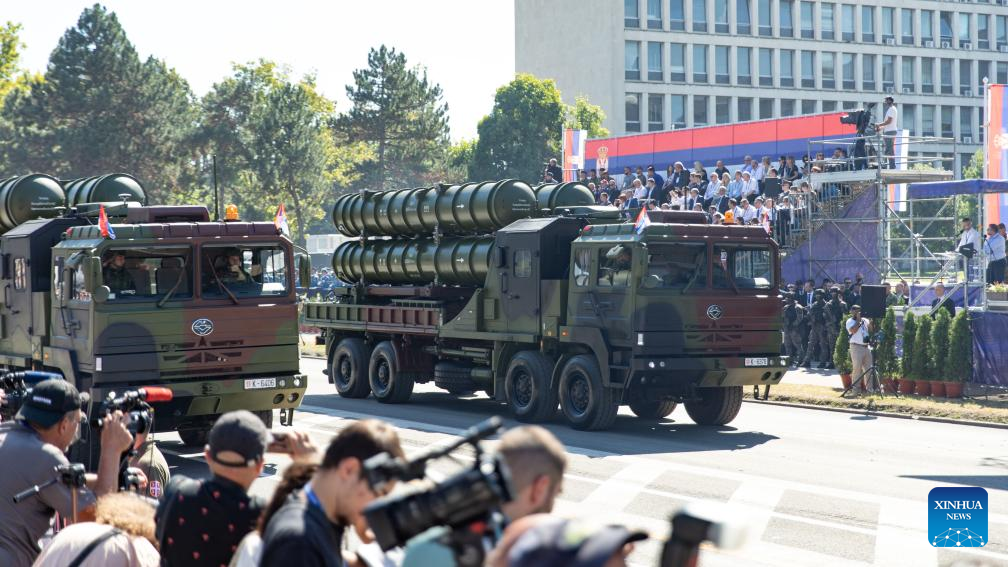Serbia Holds Massive Military Parade, Demonstrating Strength
On September 20, 2025, Serbia staged its largest-ever military parade in Belgrade, showcasing advanced weaponry from China, Russia, Israel, and France amid rising domestic unrest and regional tensions.

Serbia held its most extensive military parade in modern history on September 20, 2025, in Belgrade, marking the Day of Serbian Unity, Freedom, and National Flag. The event, titled “Strength of Unity,” featured approximately 10,000 troops, more than 2,500 pieces of military equipment, 600 vehicles, 70 aircraft, and 20 vessels. President Aleksandar Vucic presided over the parade, describing it as a demonstration of national pride and a message of deterrence to foreign adversaries, particularly as Serbia is surrounded by NATO member states. The parade drew over 47,000 spectators, with a 300-meter national flag carried by cadets to emphasize national solidarity.
Foreign Weaponry and Strategic Partnerships
The parade prominently displayed a diverse arsenal, including Chinese-made HQ-22 and HQ-17 missile systems, Russian Krasukha electronic-warfare platforms, Israeli PULS rocket artillery, and French Rafale fighter jets. The HQ-22 and HQ-17 systems, already tested by the Chinese military, were highlighted as forming a comprehensive air defense network for Serbia. The appearance of Russian Krasukha-2 and Krasukha-4 electronic-warfare systems marked the first official confirmation of their delivery to Serbia, raising concerns among defense analysts about the impact on regional air and space surveillance and NATO interoperability. The Israeli PULS system, capable of striking targets up to 300 kilometers away, and the flyover by French Rafales—part of a recent Serbian order—underscored Belgrade’s efforts to diversify its military suppliers while deepening ties with Moscow and Beijing.
Domestic Unrest and Political Motives
While the government framed the parade as a celebration of unity and military modernization, critics and opposition leaders accused President Vucic of using the event to bolster his increasingly authoritarian rule. The parade occurred against a backdrop of ongoing student-led protests and widespread anti-corruption demonstrations, which began after a deadly infrastructure collapse in Novi Sad in late 2024. Rights groups reported that some state employees were pressured to attend the parade, and riot police prevented opposition supporters from joining the crowds. Vucic has refused calls for early parliamentary elections and has intensified crackdowns on dissent, with hundreds of thousands participating in protests over the past ten months.
Regional Implications and Symbolism
The timing and scale of the parade were not lost on regional observers. Held on a date presented as the “coronation” of Serbian unity, the event was interpreted by some experts as a direct message to neighboring countries, particularly Kosovo, and as a signal of Serbia’s willingness to assert its interests militarily. The introduction of advanced electronic-warfare and missile systems into the Western Balkans has heightened concerns among NATO members and regional governments about the potential for escalation and the shifting balance of power.
Domestic Industry and Modernization
In addition to foreign systems, Serbia used the parade to debut its new Aleksandar Unifier 4x4 armored vehicle, a modular, domestically produced platform designed for patrol, convoy escort, and counter-drone operations. The vehicle’s introduction was intended to showcase Serbia’s commitment to military modernization and self-reliance, with officials highlighting its adaptability for both domestic security and potential export markets. The parade’s display of homegrown and imported technology was carefully curated to project an image of a modern, capable, and independent Serbian military.
The parade’s scale, symbolism, and political context have drawn both domestic and international scrutiny, with many questioning whether the show of force was aimed more at shoring up the government’s position at home than at deterring external threats.
Sources
-
The Daily CPEC
Serbia Military Parade Showcases Chinese Missile S...
-
The Independent
Serbia stages a large military parade to showcase...
-
United24Media
Serbia Unveils Russia's Krasukha EW Systems in Bel...
-
EUA Live
Vučić flexes muscles and rattles weapons with mass...
-
Army Recognition
Serbia debuts Aleksandar Unifier 4x4 armored vehic...
-
Telegrafi
Military parade in Belgrade, experts: Direct threa...
-
Newsmax Balkans
Military Parade "Strength of Unity" Held - Newsmax...
-
Serbian Monitor
A military parade held in Belgrade: French Rafales...